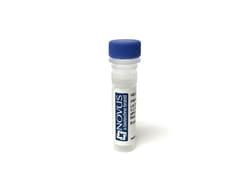Laminin gamma 1 Antibody (A5) - IHC-Prediluted, Novus Biologicals™
Manufacturer: Novus Biologicals
Select a Size
| Pack Size | SKU | Availability | Price |
|---|---|---|---|
| Each of 1 | NBP248357-Each-of-1 | In Stock | ₹ 46,636.00 |
NBP248357 - Each of 1
In Stock
Quantity
1
Base Price: ₹ 46,636.00
GST (18%): ₹ 8,394.48
Total Price: ₹ 55,030.48
Antigen
Laminin gamma 1
Classification
Monoclonal
Conjugate
Unconjugated
Formulation
10mM PBS and 0.05% BSA with 0.05% Sodium Azide
Gene Symbols
LAMC1
Immunogen
Murine EHS laminin preparation
Purification Method
Protein A or G purified
Regulatory Status
RUO
Primary or Secondary
Primary
Test Specificity
Laminins are large hetero-trimeric, non-collagenous glycoproteins composed of alpha, beta, and gamma chains. This monoclonal antibody reacts with laminin B2/1 chain of ∼210kDa and does not cross-react with other basement membrane components or fibronectin. Its specificity was established by immunoprecipitation and immunofluorescence of human skeletal muscle and kidney with laminin chain-specific monoclonal antibodys. Epithelial sheets in vivo are separated from the mesenchymal elements of the stroma by a thin layer of a specialized type of extracellular matrix termed the basement membrane (BM). This structure consists of individual components, some of which are ubiquitous in BMs and some are not. The ubiquitous ones comprise laminin (LN), entactin/nidogen (EN), collagen type IV (CIV), and large heparan sulfate proteoglycan (HSPG), which interact specifically with each other to form a continuous and regular BM. Alterations of BM integrity, from local discontinuities up to complete loss, are described in many types of human and animal epithelial neoplasms. This monoclonal antibody stains uniformly all human and murine basement membranes.
Content And Storage
Store at 4C.
Isotype
IgG2a κ
Applications
Immunohistochemistry (Paraffin)
Clone
A5
Dilution
Immunohistochemistry-Paraffin
Gene Alias
LAMB2Laminin-7 subunit gamma, Laminin B2 chain, laminin subunit gamma-1, laminin, gamma 1 (formerly LAMB2), Laminin-1 subunit gamma, Laminin-10 subunit gamma, Laminin-11 subunit gamma, Laminin-2 subunit gamma, Laminin-3 subunit gamma, Laminin-4 subunit gamma, Laminin-6 subunit gamma, Laminin-8 subunit gamma, Laminin-9 subunit gamma, MGC87297, S-LAM gamma, S-laminin subunit gamma
Host Species
Rat
Molecular Weight of Antigen
210 kDa
Quantity
7 mL
Research Discipline
Apoptosis, Cancer, Cytoskeleton Markers, Extracellular Matrix, Tumor Suppressors
Gene ID (Entrez)
3915
Target Species
Human, Mouse, Bovine
Form
Purified
Description
- Laminin gamma 1 Monoclonal specifically detects Laminin gamma 1 in Human, Mouse, Bovine samples
- It is validated for Immunohistochemistry, Immunohistochemistry-Paraffin, Immunohistochemistry-Frozen.

